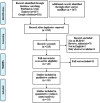Role of platelet-to-lymphocyte count ratio (PLR), as a prognostic indicator in COVID-19: A systematic review and meta-analysis
- PMID: 34436785
- PMCID: PMC8661888
- DOI: 10.1002/jmv.27297
Role of platelet-to-lymphocyte count ratio (PLR), as a prognostic indicator in COVID-19: A systematic review and meta-analysis
Abstract
Prognostic predictors are of paramount interest for prompt intervention and optimal utilization of the healthcare system in the ongoing context of the COVID-19 pandemic. The platelet-to-lymphocyte count ratio (PLR), has emerged as a potential tool for risk stratification of critically ill patients with sepsis. The current systematic review explores the utility of PLR as a prognostic predictor of COVID-19 patients. We screened the electronic databases until May 15, 2021 after enrolling in PROSPERO (CRD42021220269). Studies evaluating the association between PLR on admission and outcomes in terms of mortality and severity among COVID-19 patients were included. We retrieved 32 studies, with a total of 2768 and 3262 COVID-19 patients for mortality and disease severity outcomes. Deceased and critically ill patients had higher PLR levels on admission in comparison to survivors and non-severe patients (mean differences [MD] = 66.10; 95% confidence interval [CI]: 47.75-84.44; p < 0.00001 and MD = 86.74; 95% CI: 67.7-105.7; p < 0.00001, respectively). A higher level of PLR on admission in COVID-19 patients is associated with increased morbidity and mortality. However, the evidence is of low quality and further studies regarding the cut-off value of PLR are the need of the hour.
Keywords: Coronavirus disease 2019; Platelet-lymphocyte count ratio; Severe acute respiratory syndrome coronavirus-2.
© 2021 Wiley Periodicals LLC.
Conflict of interest statement
The authors declare that there are no conflict of interests.
Figures




References
-
- Qin B, Ma N, Tang Q, et al. Neutrophil to lymphocyte ratio (NLR) and platelet to lymphocyte ratio (PLR) were useful markers in assessment of inflammatory response and disease activity in SLE patients. Mod Rheumatol. 2016;26:372‐376. - PubMed
-
- Li B, Zhou P, Liu Y, et al. Platelet‐to‐lymphocyte ratio in advanced cancer: review and meta‐analysis. Clin Chim Acta. 2018;483:48‐56. - PubMed
-
- Jiang S, Liu J, Chen X, et al. Platelet‐lymphocyte ratio as a potential prognostic factor in gynecologic cancers: a meta‐analysis. Arch Gynecol Obstet. 2019;300:829‐839. - PubMed
-
- Mertoglu C, Gunay M. Neutrophil‐lymphocyte ratio and platelet‐lymphocyte ratio as useful predictive markers of prediabetes and diabetes mellitus. Diabetes Metab Syndr. 2017;11(suppl 1):S127‐131. - PubMed
Publication types
MeSH terms
LinkOut - more resources
Full Text Sources
Medical

